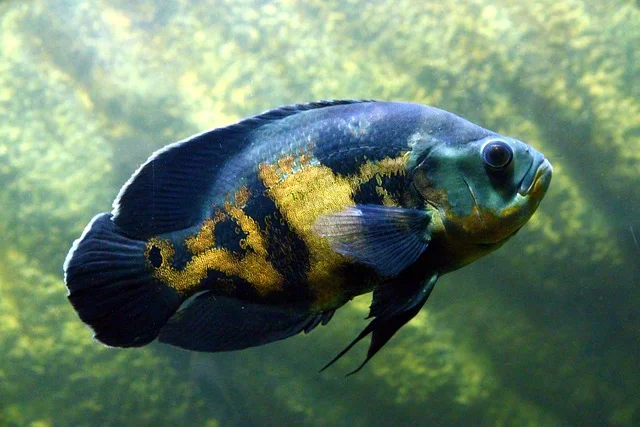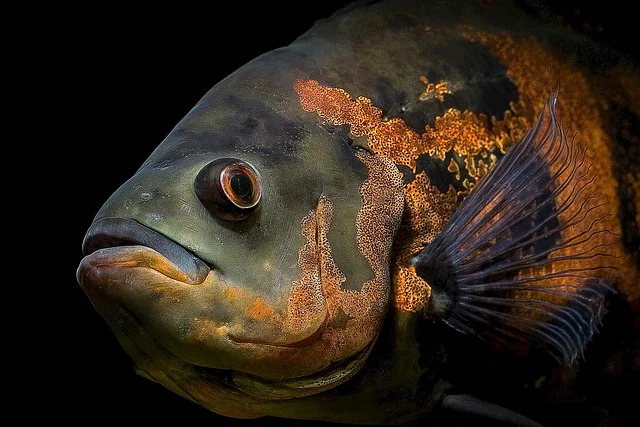Oscar fish, scientifically known as Astronotus ocellatus, is a stunning and popular freshwater fish species. These intelligent and interactive creatures boast vibrant colors and engaging personalities, making them an excellent choice for both beginner and experienced fish keepers. In this article, we will delve into the fascinating world of Oscar fish, exploring their origin, care requirements, feeding habits, behavior, breeding, and more. Let’s dive in!
The Origin and Characteristics of Oscar Fish
Oscar fish are native to the Amazon River basin in South America, specifically found in countries like Brazil, Colombia, Ecuador, and Peru. They inhabit slow-moving rivers, lakes, and flooded forests, thriving in warm tropical climates. Oscars are renowned for their striking appearance, with a variety of color patterns ranging from vibrant orange, red, and yellow to velvety black and white. Their unique patterns and impressive size, reaching up to 12-16 inches (30-40 cm) in captivity, make them a visually stunning addition to any aquarium.
| Characteristic | Description |
|---|---|
| Scientific Name | Astronotus ocellatus |
| Common Name | Oscar, Tiger Oscar |
| Size | Typically 10-16 inches (25-40 cm) in length |
| Lifespan | 10-15 years or more with proper care |
| Habitat | Native to the Amazon River basin in South America |
| Color Variations | Various color patterns, including tiger stripes, red, albino, and more |
| Body Shape | Oval-shaped and laterally compressed |
| Sexual Dimorphism | Difficult to distinguish males from females visually |
| Diet | Carnivorous; prefers live or frozen foods like fish, shrimp, and insects, but accepts high-quality pellets and flakes |
| Behavior | Intelligent and interactive; can be territorial and aggressive, especially during breeding |
| Tank Size | Requires a large aquarium, at least 75 gallons (284 liters) for adults |
| Water Parameters | Temperature: 74-81°F (23-27°C), pH: 6.0-8.0, water hardness: 5-20 dGH |
Some popular types of Oscar fish:
- Tiger Oscar: This variety features a striking pattern resembling tiger stripes, with a dark base color and vibrant orange or red markings.
- Albino Oscar: Albino Oscars lack pigmentation and have a pale pink or white body with red or orange eyes. They are highly sought after for their unique appearance.
- Red Oscar: Red Oscars have a deep red or orange coloration throughout their body, often with contrasting patterns or markings.
- Lutino Oscar: Lutino Oscars exhibit a bright yellow or golden coloration. They have a unique charm and stand out in any aquarium.
- Wild-Type Oscar: The wild-type Oscars have a natural appearance, typically displaying a dark base color with scattered patterns of orange, red, or black.
- Longfin Oscar: Longfin Oscars have elongated and flowing fins, adding a graceful touch to their appearance. They come in various color variations.

Setting Up the Ideal Aquarium for the Oscars
Creating a suitable habitat for the Oscars is essential to their overall well-being. Here are some key considerations when setting up an aquarium for the Oscars:
Tank Size and Water Conditions
| Tank Size (Gallons) | Number of Oscars |
|---|---|
| 75 gallons or larger | 1 Oscar |
| 125 gallons or larger | 2 Oscars |
| 175 gallons or larger | 3 Oscars |
| 225 gallons or larger | 4 Oscars or more |
Oscars require a spacious tank due to their size and territorial nature. A minimum tank size of 75 gallons (283 liters) is recommended for a single Oscar, with an additional 50 gallons (189 liters) per additional fish. The water temperature should be maintained between 74-81°F (23-27°C), with a pH level ranging from 6.5 to 7.5. Good filtration and regular water changes are crucial to keeping the water clean and well-oxygenated.
Decor and Substrate
Provide ample hiding spots and caves using rocks, driftwood, or PVC pipes to mimic their natural habitat. Oscars rearrange their surroundings, so ensure that any decorations are securely positioned. Use a sandy or gravel substrate that allows easy cleaning and prevents injury to the fish.
Lighting and Plants
Moderate lighting is sufficient for Oscars, as excessive brightness can cause stress. Select hardy aquatic plants like Anubias, Java Fern, or Amazon Sword that can withstand their occasional nibbling or digging. Adding live plants enhances the aesthetics and helps maintain water quality by reducing nitrate levels.
Feeding and Nutrition for Oscars
Oscars are omnivorous and have a hearty appetite. A well-balanced diet plays a crucial role in their growth and vibrant coloration. Their diet should consist of varieties of high-quality pellet or flake food specially formulated for cichlids. Supplement their diet with occasional treats such as live or frozen foods like brine shrimp, bloodworms, or small fish. Feed them twice daily, only providing what they can consume in a few minutes to prevent overeating and water pollution.
- Carnivorous Diet: Oscars are primarily carnivorous fish that require a diet rich in animal-based protein.
- High-Quality Pellets: Offer high-quality pellet foods designed for large cichlids as the primary staple of their diet. Look for options with a high protein content.
- Variety is Key: While pellets can make up the main diet, vary their meals with occasional treats of live or frozen foods. Good choices include feeder fish, earthworms, crickets, shrimp, and small crustaceans.
- Avoid Overfeeding: Oscars have hearty appetites, but it’s important not to overfeed. Offer an amount they can consume in about two minutes, and adjust based on their appetite.
- Frequency: Typically, feed adult Oscars once a day. Juveniles may require more frequent feedings, up to 2-3 times a day.
- Monitor Growth: Adjust their diet as they grow. Young Oscars need more protein for growth, while adults benefit from a slightly lower protein content.
- Supplement with Vegetables: While primarily carnivorous, Oscars can also benefit from some vegetable matter in their diet. Offer blanched spinach, cucumber, or peas occasionally for fiber and variety.
- Calcium and Vitamin Supplements: Oscars can benefit from occasional calcium and vitamin supplements to ensure overall health and strong bones.
- Live Feeding Caution: Be cautious with live feeder fish as they can introduce diseases. If you choose to use them, quarantine feeder fish before offering them to your Oscars.
- Maintain Cleanliness: Remove any uneaten food promptly to maintain water quality and prevent potential health issues.
- Consult a Veterinarian: If you’re unsure about their diet or if they show signs of nutritional deficiencies, consult with a veterinarian or an experienced aquarium hobbyist for guidance.

Oscar Fish Behavior and Compatibility
Oscars possess distinct personalities and can be highly interactive with their owners. They are known to recognize their caregivers and may even wag their tails or splash water when excited. However, it’s essential to understand their behavior and compatibility with other fish species.
Oscars are semi-aggressive and territorial by nature. They may exhibit aggression towards smaller or passive tankmates, especially when breeding or defending their territory. Compatible tankmates include larger cichlids like Severums, Jack Dempseys, or Silver Dollars. Avoid keeping them with small, fin-nipping fish or delicate species. Careful observation and monitoring of tank dynamics are crucial to ensure the well-being of all inhabitants.
Common Diseases and Health Issues in Oscars
Like any other fish, Oscars are susceptible to certain diseases and health issues. Here are some common ailments observed in Oscar fish:
Hole-in-the-Head Disease (Hexamita)
This condition is characterized by the development of holes or pits on the head and lateral line. It is caused by poor water conditions, improper diet, or a weakened immune system. Treating hole-in-the-head disease requires improving water quality, providing a balanced diet, and administering appropriate medications as prescribed by a veterinarian.
Ich (White Spot Disease)
Ich is a parasitic infection that manifests as tiny white spots on the fish’s body and fins. It causes itching and discomfort, leading to flashing or rubbing against objects. Ich can be treated by gradually increasing the water temperature to 86°F (30°C) and using medications like malachite green or copper sulfate. Quarantine infected fish to prevent the spread of the disease.
Breeding Oscar Fish
Breeding Oscars can be an exciting endeavor for dedicated fish keepers. To encourage successful breeding, create favorable conditions such as providing appropriate tank size, stable water parameters, and a suitable breeding site. Oscars are known to form monogamous pairs, and both parents participate in guarding and caring for the eggs and fry. Breeding Oscars requires dedication, patience, and careful monitoring of the breeding pair.
Here’s a step-by-step guide for beginners on how to breed Oscars:
Step 1: Prepare a Breeding Tank
1.1. Set up a separate breeding tank. A tank size of at least 75 gallons (283 liters) is recommended.
1.2. Use a sponge filter or a gentle air-driven filter to maintain water quality without strong currents.
1.3. Provide hiding places in the form of PVC pipes, flower pots, or other suitable materials for the Oscars to lay their eggs.
1.4. Maintain the water temperature between 77-82°F (25-28°C) and keep the pH around 6.0-7.0.
Step 2: Select a Breeding Pair
2.1. Choose a mature breeding pair. Oscars typically reach sexual maturity at around 1-2 years of age.
2.2. Observe their behavior in the main tank and look for signs of compatibility. Oscars can be territorial, so it’s important that the pair gets along.
Step 3: Conditioning
3.1. Condition the breeding pair with a high-quality diet rich in protein. Live and frozen foods can be especially beneficial.
3.2. Increase the frequency of feedings to twice a day to promote health and readiness for spawning.
Step 4: Induce Spawning
4.1. Once the Oscars are well-conditioned, increase the water temperature by a few degrees to simulate the onset of the rainy season in their natural habitat. This can trigger spawning behavior.
4.2. Perform partial water changes with slightly cooler water to mimic the change in temperature that often occurs during the rainy season.
Step 5: Courtship and Spawning
5.1. Oscars are known for their elaborate courtship rituals. The male will usually display more intense coloration and may dig pits in the substrate.
5.2. The female will lay her eggs on a flat surface, such as a rock or a flowerpot, and the male will fertilize them. Oscars are substrate spawners.
Step 6: Care for Eggs and Fry
6.1. After spawning, Oscars are protective parents, but they can also become aggressive. It’s often a good idea to remove other tankmates.
6.2. The parents will fan the eggs with their fins to keep them aerated and free from debris.
6.3. The eggs will hatch in about 2-3 days, and the fry will remain in a pit dug by the parents.
6.4. Initially, the fry will feed on their yolk sacs. After that, start offering them finely crushed flake food or newly hatched brine shrimp.
Step 7: Gradual Separation
7.1. Once the fry is free-swimming and large enough to handle themselves, usually after a few weeks, consider separating them from the parents to prevent aggression.
Step 8: Growth and Maintenance
8.1. Continue to provide a balanced diet for the young Oscars, gradually increasing the size of food particles as they grow.
8.2. As they mature, monitor their behavior for signs of aggression, and be prepared to separate them if necessary.
Oscars as a Popular Choice for Aquarium Enthusiasts
Oscar fish have gained immense popularity in the aquarium hobby due to their striking appearance, interactive nature, and ability to form strong bonds with their owners. Their vibrant colors and engaging behaviors make them captivating to watch. Whether you are a beginner or an experienced aquarist, Oscars can be a rewarding and visually stunning addition to your home aquarium.
Conclusion
Oscar fish are amazing creatures that bring vibrancy and charm to any aquarium. Their stunning colors, engaging personalities, and unique behaviors make them a favorite choice among fish enthusiasts. By understanding their origin, care requirements, feeding habits, behavior, and breeding, you can provide the optimal environment for Oscars to thrive. Remember to maintain suitable tank conditions, provide a balanced diet, and carefully select compatible tank mates. With proper care and attention, the Oscars will reward you with their beauty and fascinating interactions.
Frequently Asked Questions (FAQs)
-
What size tank do the Oscars need?
Oscars require a minimum tank size of 75 gallons (283 liters) for a single fish.
-
Can Oscars be kept with other fish?
Oscars are semi-aggressive and should be kept with compatible tankmates, preferably larger cichlids.
-
How often should I feed my Oscars?
Feed your Oscars twice daily, providing what they can consume in a few minutes.
-
Do Oscars recognize their owners?
Yes, Oscars are known to recognize their owners and can exhibit interactive behaviors.
-
Can Oscars live in a community tank?
While Oscars are not ideal for a community tank, they can coexist with carefully selected tankmates.
-
Is Oscar fish expensive?
Oscar fish are relatively affordable compared to other exotic fish species. Prices can vary based on factors such as size, coloration, and rarity.
-
Is Oscar fish a good pet?
Oscar fish can make great pets for dedicated aquarium enthusiasts. They have vibrant colors, interactive behaviors, and can form strong bonds with their owners.
-
Are Oscar fish aggressive?
Oscar fish are known for their semi-aggressive nature. They can exhibit territorial behavior and may show aggression towards smaller or passive tankmates.
-
Why is Oscar fish so popular?
Oscar fish have gained popularity due to their stunning appearance, engaging personalities, and ability to form strong connections with their owners. Their vibrant colors and interactive behaviors make them an excellent choice for aquarium enthusiasts.
Sources & References
The Cichlid Aquarium, Germany: Tetra Press- Loiselle; Paul V (1995).
American Cichlids II: Large Cichlids: A Handbook for Their Identification, Care, and Breeding – Staeck, Wolfgang; Linke, Horst (1995)




